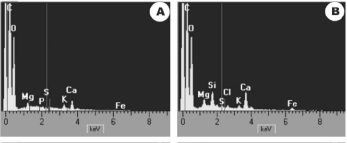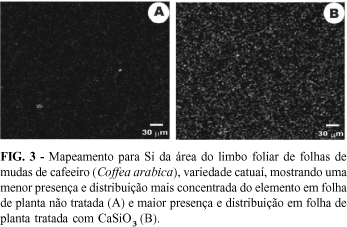Brown eye spot of coffee (Coffea arabica) is an important nursery disease. The goal of this work was to evaluate the effect of silicon (1 g of CaSiO3 incorporated in 1 kg of substrate used to fill the containers) on the control of this disease in three coffee cultivars, catuaí, mundo novo and icatú, and to determine which resistance factors were stimulated. Young plants with two pairs of leaves were inoculated with a suspension containing 1.4 x 10(4) Cercospora coffeicola conidia.ml-1. Seven months after inoculation the plants were evaluated to determine the percentage of leaves with disease (%) and the total number of lesions per plant. Before the evaluation, leaf samples were studied using a scanning electron microscope and X-ray microanalysis. In the catuaí cultivar treated with silicon, ther was a reduction of 63,2% of leaves with lesions and 43% of total lesions per plant, in relationship the non-treated plants. X-ray microanalysis and mapping of Si showed uniform distribution of elements on all abaxial surfaces of leaves in all the treated cultivars. On leaves of non-treated plants, the Si was rare or absent. Scanning electron microscopy also showed a very well developed wax layer on the lower leaf surfaces of all cultivars, but this layer was thicker in the catuaí cultivar and thin or absent in control plants.




